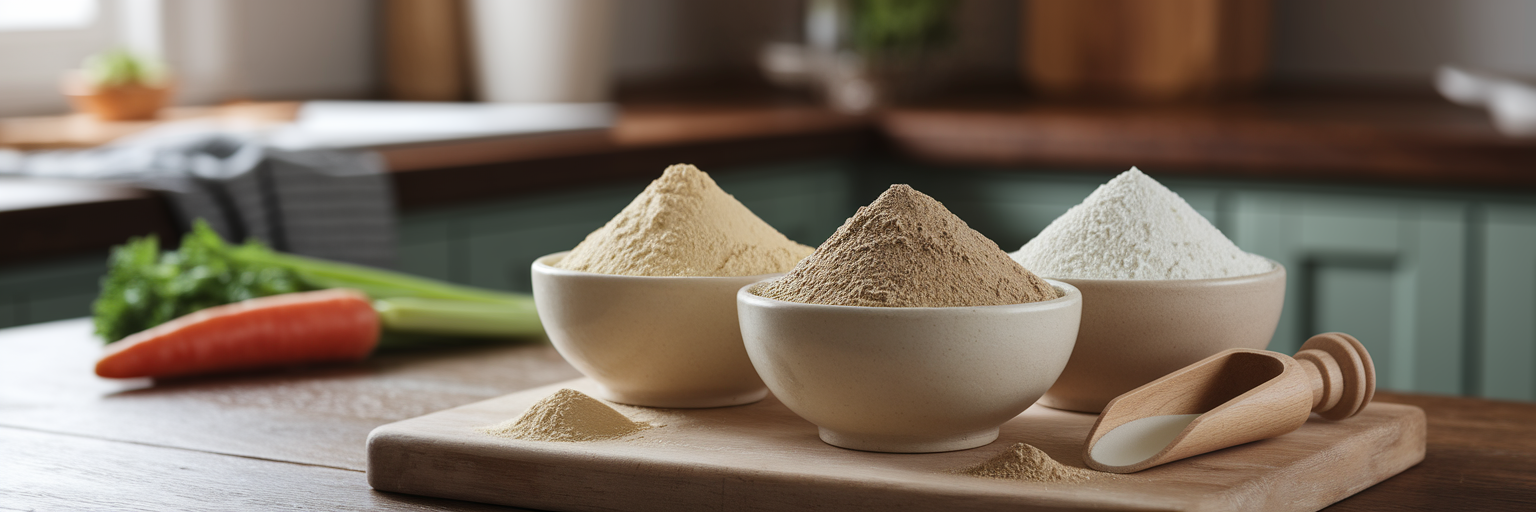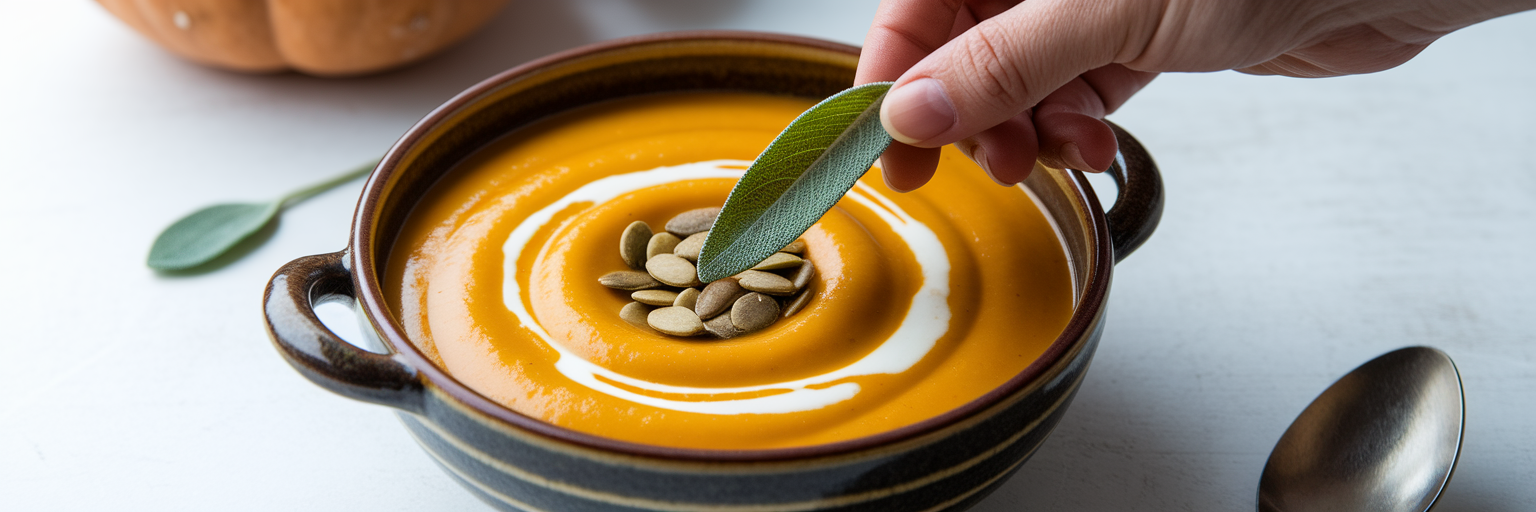Why Add Protein Powder to Your Soups?
There’s nothing quite like a warm bowl of soup on a chilly day. It’s the ultimate comfort food, a simple way to nourish your body and soul. But if you follow a plant-based diet, you’ve probably noticed a common problem. Many delicious vegetable soups just don’t have the staying power to keep you full, leaving you hungry again an hour later.
This is where vegan protein powder comes in. It’s a surprisingly simple and effective way to transform a light broth or purée into a complete, satisfying meal. Adding a scoop is one of the easiest ways to boost the protein content without piling on extra ingredients or spending more time in the kitchen.
Now, you might be thinking, "Protein powder in my soup? Won't that taste weird or get clumpy?" It’s a fair question, but you can relax. With the right powder and a couple of simple tricks, you can avoid any strange flavors or textures. This article will show you exactly how to do it, turning your favorite soups into hearty, protein-packed meals.
Picking the Perfect Plant-Based Protein Powder

The single most important step to a delicious protein-boosted soup is choosing the right powder. This isn't the time for the vanilla or chocolate blends you use in your morning smoothies. Those are formulated with sweeteners and flavors that will clash with your savory soup.
Instead, you need to look for unflavored and unsweetened protein powders. Options like pea, brown rice, or hemp protein have neutral, slightly earthy profiles that blend seamlessly into savory dishes. When you’re shopping, become a label detective. Look for a minimal ingredient list without any added sugars, stevia, or sucralose. The simpler, the better. This focus on clean ingredients is one of the most versatile unflavored vegan protein powder uses, extending far beyond just soups.
This is the foundation of successful plant based protein for cooking. While some brands are starting to offer savory-flavored powders, they are less common and can be limiting. An unflavored powder is a blank canvas. If you're exploring different options, looking at a breakdown of the best protein powders can help you find the perfect match for your cooking style.
| Protein Type | Flavor Profile | Best For (Texture) | Pro Tip |
|---|---|---|---|
| Pea Protein | Neutral, slightly earthy | Creates a thicker, creamier consistency | Excellent for puréed soups like butternut squash or potato leek. |
| Brown Rice Protein | Very mild, slightly grainy | Adds body without much thickening | A good all-purpose choice that disappears into chunky stews. |
| Hemp Protein | Nutty, distinctly earthy | Can add a slightly denser texture | Best in robustly flavored soups like lentil or black bean where its taste is complementary. |
The Secret to Clump-Free Protein Soups
Let’s tackle the biggest fear head-on: lumpy soup. Nobody wants that. The good news is that a perfectly smooth texture is easy to achieve every single time. It all comes down to one foolproof technique called the "slurry method."
This method ensures the powder dissolves completely before it ever touches your hot soup. Here’s how you do it:
- Measure: Scoop your desired amount of protein powder into a small bowl.
- Mix: Add a few tablespoons of a cool or room-temperature liquid. You can use water, plant-based milk, or even a little bit of the broth you’ve ladled from the pot and allowed to cool.
- Whisk: Use a small whisk or a fork to mix vigorously until you have a smooth, thick paste with no dry clumps. It should look like pancake batter.
The timing of adding protein powder to hot food is just as important as the method. You should stir the slurry into your soup at the very end of the cooking process, after you’ve turned off the heat. High heat can cause the protein to denature and clump together, which is exactly what we want to avoid. As culinary experts at Lakewinds Food Co-op note, adding protein powder off-heat is crucial for preserving both its nutritional value and smooth texture.
For puréed soups, it’s even easier. Simply add the protein powder directly into the blender along with your cooked vegetables and broth, then blend until everything is silky smooth.
Keeping Your Soups Delicious

Even unflavored protein powders can have a subtle, earthy taste. But instead of trying to hide it, you can use it as an opportunity to build deeper, more complex flavors in your soup. With a few pantry staples, you can make sure your protein-boosted soup is the most delicious one you’ve ever made.
Here are a few strategies to balance and enhance the flavor:
- Boost Umami: Umami is that rich, savory flavor that makes food so satisfying. Stir in a teaspoon of miso paste, a tablespoon of nutritional yeast, or a dash of tamari or soy sauce. These ingredients create a savory backbone that complements the protein powder perfectly.
- Add Acidity and Spice: A squeeze of fresh lemon or lime juice added right at the end can brighten up the entire dish and cut through any richness. Spices like smoked paprika, cumin, or a pinch of cayenne pepper also add warmth and complexity that work well with earthy notes.
- Finish with Fresh Herbs: Never underestimate the power of fresh herbs. A handful of chopped parsley, cilantro, or dill stirred in just before serving adds a burst of freshness that makes the whole soup taste more vibrant.
These flavor tips can be applied to almost any dish, and you can find more delicious ideas on our blog to keep your meals exciting.
Three Easy High-Protein Vegan Soup Recipes
Ready to put these tips into practice? Here are three of our favorite high protein vegan soup recipes to get you started. Each one is simple, delicious, and designed to give you the confidence to start experimenting on your own.
Creamy Red Lentil & Spinach Stew
This hearty and comforting creamy vegan lentil soup is a perfect weeknight meal.
- Ingredients: 1 tbsp olive oil, 1 onion, 2 carrots, 2 celery stalks, 2 cloves garlic, 1 tsp cumin, 1/2 tsp turmeric, 1 cup red lentils, 4 cups vegetable broth, 2 large handfuls of spinach, 1-2 scoops unflavored pea protein powder, salt, and pepper.
-
Instructions:
- Sauté diced onion, carrots, and celery in olive oil until soft. Add minced garlic and spices and cook for another minute.
- Rinse lentils and add them to the pot with the vegetable broth. Bring to a boil, then reduce heat and simmer for 15-20 minutes, or until lentils are tender.
- Turn off the heat. Stir in the spinach until it wilts.
- In a separate bowl, make a slurry with the protein powder and a little water. Stir the slurry into the stew until fully combined. Season with salt and pepper to taste.
Roasted Butternut Squash & Ginger Soup
A silky, smooth soup with a gentle warmth from the ginger.
- Ingredients: 1 medium butternut squash, 1 tbsp olive oil, 1 onion, 1-inch piece of ginger, 3 cups vegetable broth, 1-2 scoops unflavored brown rice or pea protein powder, salt, and pepper.
-
Instructions:
- Roast the halved and seeded butternut squash at 400°F (200°C) for 40-50 minutes until tender.
- Sauté diced onion in olive oil until soft. Add grated ginger and cook for one minute.
- Scoop the roasted squash flesh into the pot. Add the vegetable broth and bring to a simmer for 5 minutes.
- Carefully transfer the soup to a blender. Add the protein powder, salt, and pepper. Blend until completely smooth.
Hearty Black Bean & Corn Soup
A quick, flavorful soup inspired by Tex-Mex flavors.
- Ingredients: 1 tbsp olive oil, 1 onion, 1 bell pepper, 2 cloves garlic, 1 tbsp chili powder, 1 tsp cumin, 1 can (15 oz) black beans (rinsed), 1 can (15 oz) diced tomatoes, 1 cup frozen corn, 3 cups vegetable broth, 1-2 scoops unflavored hemp or pea protein powder.
-
Instructions:
- Sauté diced onion and bell pepper in olive oil until soft. Add minced garlic and spices and cook for one minute.
- Add the black beans, tomatoes, corn, and broth. Simmer for 10 minutes.
- Turn off the heat. Make a slurry with the protein powder and a little water, then stir it into the soup until combined. Serve with a squeeze of lime and fresh cilantro.
Once you've mastered these, you'll be ready to explore even more easy vegan protein recipes you'll actually crave.
More Ways to Boost Protein in Vegan Soups

While protein powder is a fantastic tool, it’s just one of many ways to make your soups more satisfying. Thinking about protein at every stage of the cooking process can help you build a truly nourishing meal from the ground up.
- Build a Protein-Rich Base: Start with ingredients that are naturally high in protein. Lentils, chickpeas, black beans, and quinoa are all excellent foundations for a hearty soup or stew. Crumbled firm tofu can also add a "meaty" texture and a solid protein punch.
- Use Whole-Food Thickeners: Instead of just using flour or cornstarch, create a creamy texture with protein-rich ingredients. Blending soaked raw cashews, a can of white beans, or a block of silken tofu into your soup base adds creaminess and a significant amount of protein.
- Power Up Your Garnishes: Don’t forget the toppings. A sprinkle of crunchy roasted chickpeas, toasted pumpkin seeds, or hemp hearts over your finished soup adds texture, flavor, and a final boost of protein.
Building a healthy, high-protein pantry is easy when you have the right ingredients, and you can explore our full collection of plant-based products to get started.
Your New Favorite Way to Enjoy Soup
You’re now ready to transform any soup from a light starter into a filling main course. The key is to remember the simple steps: choose an unflavored powder, make a smooth slurry, stir it in at the very end, and balance the flavors with a little umami or acid. This is how to use protein powder in soup to get great results every time.
Start experimenting with your favorite recipes. If you’re nervous, begin with just half a scoop to see how you like it. You’ll be amazed at how easy it is to create a satisfying, protein-packed meal.
Ready to turn your favorite soup into a satisfying meal? Give it a try and share your creation with us below!



